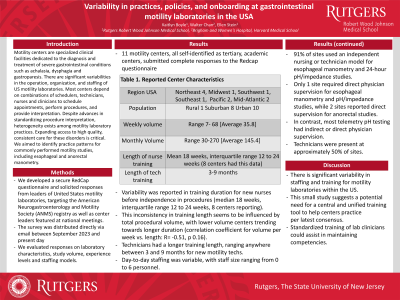Tuesday Poster Session
Category: Functional Bowel Disease
P4045 - Variability in Practices, Policies, and Onboarding at Gastrointestinal Motility Laboratories in the USA
Tuesday, October 29, 2024
10:30 AM - 4:00 PM ET
Location: Exhibit Hall E

Has Audio
.jpg)
Kaitlyn Boyle, MS (she/her/hers)
Robert Wood Johnson Medical School, Rutgers University
New Brunswick, NJ
Presenting Author(s)
Walter Chan, MD1, Ellen M. Stein, MD, FACG2, Kaitlyn Boyle, MS2
1Brigham and Women's Hospital, Harvard Medical School, Boston, MA; 2Robert Wood Johnson Medical School, Rutgers University, New Brunswick, NJ
Introduction: There are significant variabilities in the operation, organization, and staffing of US motility laboratories. Most centers depend on combinations of schedulers, technicians, nurses and clinicians to schedule, perform procedures, and provide interpretation. Expanding access to high quality care is critical to study. Despite advances in standardizing procedure interpretation, heterogeneity exists among motility laboratory practices. We aimed to identify practice patterns for commonly performed motility studies, including esophageal and anorectal manometry.
Methods: This study was exempt by the Rutgers IRB. We developed a RedCap survey and solicited responses from leaders of US motility labs, targeting ANMS registry of laboratories as well as center leaders featured at national meetings. The survey was distributed via email between September 2023 and present day. We gathered early information on laboratory characteristics, study volume, experience levels and staffing models.
Results: Among 11 centers submitting complete responses, 91% used an independent nursing or technician model for esophageal manometry and 24 hour pH/impedance studies. Only 1 site required direct physician supervision for these studies, while 2 sites reported direct supervision for anorectal studies. Most telemetry pH testing had indirect or direct physician supervision. Variability was reported in training duration for new nurses before independence (median 18 weeks, interquartile range12 to 24 weeks, 8 centers reporting). The variability in training length seems to be influenced by total procedural volume, with lower volume centers trending towards longer duration (correlation coefficient for volume per week vs. length: R= -0.51, p 0.16). Training length ranged from 3-9 months for new technicians. Day-to-day staffing was variable. Staffing size varied between 0 and 6 personnel. Technicians were present at approximately 50% of sites (range 0-3 technicians assisting). Sites with over 50 procedures weekly had 5 trained nurses/technicians and dedicated GI faculty.
Discussion: There is variability in staffing and training for motility lab clinicians in the US. This small study suggests a potential need for a central and unified training tool to help centers practice per latest consensus. Standardized training of lab clinicians could assist in maintaining competencies.
Note: The table for this abstract can be viewed in the ePoster Gallery section of the ACG 2024 ePoster Site or in The American Journal of Gastroenterology's abstract supplement issue, both of which will be available starting October 27, 2024.
Disclosures:
Walter Chan, MD1, Ellen M. Stein, MD, FACG2, Kaitlyn Boyle, MS2. P4045 - Variability in Practices, Policies, and Onboarding at Gastrointestinal Motility Laboratories in the USA, ACG 2024 Annual Scientific Meeting Abstracts. Philadelphia, PA: American College of Gastroenterology.
1Brigham and Women's Hospital, Harvard Medical School, Boston, MA; 2Robert Wood Johnson Medical School, Rutgers University, New Brunswick, NJ
Introduction: There are significant variabilities in the operation, organization, and staffing of US motility laboratories. Most centers depend on combinations of schedulers, technicians, nurses and clinicians to schedule, perform procedures, and provide interpretation. Expanding access to high quality care is critical to study. Despite advances in standardizing procedure interpretation, heterogeneity exists among motility laboratory practices. We aimed to identify practice patterns for commonly performed motility studies, including esophageal and anorectal manometry.
Methods: This study was exempt by the Rutgers IRB. We developed a RedCap survey and solicited responses from leaders of US motility labs, targeting ANMS registry of laboratories as well as center leaders featured at national meetings. The survey was distributed via email between September 2023 and present day. We gathered early information on laboratory characteristics, study volume, experience levels and staffing models.
Results: Among 11 centers submitting complete responses, 91% used an independent nursing or technician model for esophageal manometry and 24 hour pH/impedance studies. Only 1 site required direct physician supervision for these studies, while 2 sites reported direct supervision for anorectal studies. Most telemetry pH testing had indirect or direct physician supervision. Variability was reported in training duration for new nurses before independence (median 18 weeks, interquartile range12 to 24 weeks, 8 centers reporting). The variability in training length seems to be influenced by total procedural volume, with lower volume centers trending towards longer duration (correlation coefficient for volume per week vs. length: R= -0.51, p 0.16). Training length ranged from 3-9 months for new technicians. Day-to-day staffing was variable. Staffing size varied between 0 and 6 personnel. Technicians were present at approximately 50% of sites (range 0-3 technicians assisting). Sites with over 50 procedures weekly had 5 trained nurses/technicians and dedicated GI faculty.
Discussion: There is variability in staffing and training for motility lab clinicians in the US. This small study suggests a potential need for a central and unified training tool to help centers practice per latest consensus. Standardized training of lab clinicians could assist in maintaining competencies.
Note: The table for this abstract can be viewed in the ePoster Gallery section of the ACG 2024 ePoster Site or in The American Journal of Gastroenterology's abstract supplement issue, both of which will be available starting October 27, 2024.
Disclosures:
Walter Chan indicated no relevant financial relationships.
Ellen Stein indicated no relevant financial relationships.
Kaitlyn Boyle indicated no relevant financial relationships.
Walter Chan, MD1, Ellen M. Stein, MD, FACG2, Kaitlyn Boyle, MS2. P4045 - Variability in Practices, Policies, and Onboarding at Gastrointestinal Motility Laboratories in the USA, ACG 2024 Annual Scientific Meeting Abstracts. Philadelphia, PA: American College of Gastroenterology.
